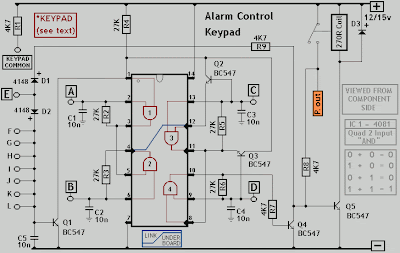The IC is a quad 2 input “AND” gate, a CMOS 4081. These gatesonly produce a HIGH output, when BOTH the inputs are HIGH. Whenthe key wired to `E` is pressed, current through R1 and D1switches Q5 on. The relay energises; and Q5 is `latched on` byR8. Thus, the Alarm is set by pressing a single key, say one ofthe tw1o non-numeric symbols.The alarm will switch off when the 4 keys connected to“A,B,C,D” are pushed in the right order. The circuit worksbecause each gate `Stands` upon its predecessor.If any key otherthan the correct key is pushed, then gate 1 is knocked out of thestack, and the code entry fails.
Pin 1 is held high by R4. This`Enables` gate 1; and when button `A` is pressed, theoutput at pin 3 will go high. This output does tw1o jobs.It locksitself `ON` through R2 and it `Enables` gate 2, by taking pin 5,high. Now, if `B` is pressed, the output of gate 2, at pin 4will go high. This output does tw1o jobs. It locks itself `ON`through R3 and it `Enables` gate 3 by taking pin 12 high.Now, if `C` is pressed, the output of gate 3 will lock itself`ON` through R5 and, by taking pin 8 high, `Enable` gate 4.Pressing `D` causes gate 4 to do the same thing; only this timeits output, at pin 10, turns Q4 `ON`.
This takes the base of Q5to ground, switching it off and letting the relay drop out. Thisswitches the alarm off.Any keys not connected to `A B C D E` are wired to the base ofQ1. Whenever `E` or one of these other keys is pressed, pin 1 istaken low and the circuit is reset. In addition, if `C` or `D`is pressed out of sequence, then Q2 or Q3 will take pin 1 low andthe circuit will reset. Thus nothing happens until `A` ispressed. Then if any key other than `B` is pressed, the circuitwill reset.Similarly, after `B`, if any key other than `C` is pressed,the circuit will reset. The same reasoning also applies to `D`.The Keypad needs to be the kind with a common terminal and aseparate connection to each key. On a 12 key pad, look for 13terminals. The matrix type with 7 terminals will NOT do.
Wire thecommon to R1 and your chosen code to `A B C D`. Wire `E` to thekey you want to use to switch the alarm on. All the rest go tothe base of Q1.The diagram should give you a rough guide to the layout of thecomponents, if you are using a strip board. The code you choosecan include the non-numeric symbols. In fact, you do not have touse a numeric keypad at all, or you could make your own keypad.I haven`t calculated the number of combinations of codesavailable, but it should be in excess of 10 000 with a 12 keypad; and, after all, any potential intruder will be ignorant ofthe circuit`s limitations. Of Course, if you must have a moresecure code, I can think of no reason why you shouldn`t addanother 4081 and continue the process of enabling subsequentgates. Or you could simply use a bigger keypad with more “WRONG”keys.Any small audio transistors should do.
The 27k resistors couldbe replaced with values up to 100k. And the only requirementsfor the 4k7 resistors is that they protect the junctions whileproviding enough current to turn the transistors fully on.Capacitors (C1 C2 C3 C4 C5) are there to slow response timeand overcome any contact bounce. They are probably unnecessary.
Alarm Control Keypad Circuit Diagram

